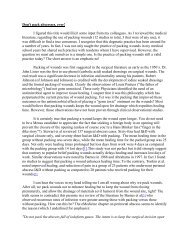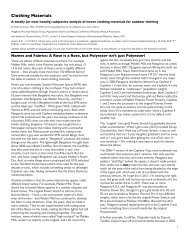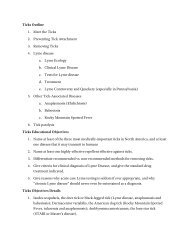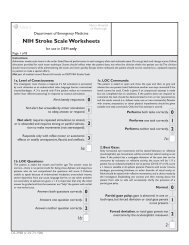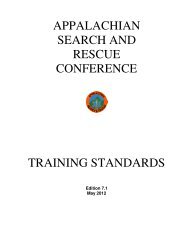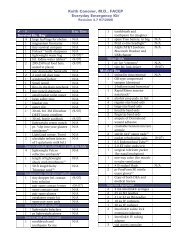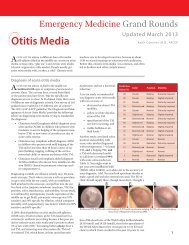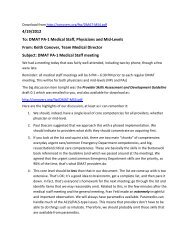Create successful ePaper yourself
Turn your PDF publications into a flip-book with our unique Google optimized e-Paper software.
6Anaplasmosis Endemic AreaLyme disease by using assays whose accuracy and clinicalusefulness have not been adequately established.These tests include urine antigen tests, immunofluorescentstaining for cell wall-deficient forms of Borreliaburgdorferi, and lymphocyte transformation tests. Inaddition, some laboratories perform polymerase chainreaction tests for B. burgdorferi DNA on inappropriatespecimens such as blood and urine or interpret Westernblots using criteria that have not been validated and publishedin peer-reviewed scientific literature. 52Sigal writes: The diagnosis should be based on symptomsand the probability of exposure to the Lyme spirochete.Laboratory evaluation is appropriate for patients whohave arthritic, neurologic, or cardiac symptoms associatedwith Lyme disease, but it is not appropriate in patients whohave nonspecific symptoms, such as those of chronic fatiguesyndrome or fibromyalgia. 53A great variety of treatments, including outright quackeryand malpractice, have evolved for the treatment ofself-diagnosed “chronic Lyme disease,” often without ahistory of positive Lyme serology. These include but arenot limited to:• colloidal silver;• intracellular hyperthermia therapy (ICHT): taking2,4-dinitrophenol (DNP) to “rev up mitochondria”and cause intracellular hyperthermia, despitethe fact that DNP, when tried as a diet medicationback in the 1930s, killed people;• rife machines (electromagnetic devices that “synctheir frequencies” to the spirochetes);• hydrogen peroxide injections, and• infecting oneself with malaria.A less overtly quackish treatment is prolonged treatmentwith antibiotics, particularly IV ceftriaxone, which hasresulted in biliary problems including likely iatrogeniccholecystitis leading to cholecystectomy. 54 One 30 yearold woman died from an infected IV that had beenin place for two years, for treatment of unsubstantiatedLyme disease. 55 Some people with fibromyalgiaor chronic fatigue and positive Lyme titres (or evenwithout such titres) are so desperate for antibiotics that,when they can’t find doctors to prescribe them, thereare reports in the popular press (see quackwatch.org)they resort to veterinary antibiotics. And some of theseantibiotic-seekers are quite politically active, and sincethey have such a hard time finding doctors to prescribetheir antibiotics (LLMDs or “Lyme-Literate MDs”),they have introduced a bill into the Pennsylvania Senate,SB 210 (www.legis.state.pa.us), in the 2011-12 session,which would ensure insurance coverage for prolongedcourses of antibiotics and prevent any misconducthearings or actions by the Board of Medicine againstthose accused of inappropriately prescribing prolongedantibiotics for presumed Lyme disease. Some LLMDsare treating problems such as autism, multiple sclerosisand amyotrophic lateral sclerosis with long-termantibiotics on the assumption that they are really formsof Lyme disease. And the chief of rheumatology at Tuftshas been harassed, stalked, and threatened by patientsand patient advocacy groups demanding that he endorselong-term antibiotic treatment for “chronic Lyme disease”– to the point where he had to be assigned securityguards. 56 There have been many media “exposés” of howmainstream doctors are ignoring the needs of “chronicLyme disease” patients for prolonged antibiotics, so thepublic perception seems to align, not with mainstreammedicine, but more with the quacks. 30Lightfoot et al concluded that for most patients witha positive Lyme antibody titer and only symptoms offatigue or nonspecific muscle pains, the risks and costsof intravenous antibiotic therapy exceed the benefits. Inareas endemic for Lyme disease, the incidence of false-positiveserologic results in patients with nonspecific myalgia orfatigue exceeds by four to one the incidence of true-positiveresults… 57 And Klempner showed, in placebo-controlledtrials, that such patients do not benefit from ninety daysof antibiotic. 58Quackwatch.org gives the following bullets as their bottomline, which I heartily endorse:• Lyme disease, when diagnosed early, is readilytreatable with oral antibiotics.• Positive antibody tests, by themselves, do notprovide a sufficient basis for diagnosing Lymedisease. The diagnosis should be based on theoverall clinical picture, including medical historyand physical findings.• Negative antibody testing after the first few weeksstrongly suggests that the patient does not haveLyme disease.• Many patients with chronic, nonspecific symptoms(such as headaches, fatigue, muscle aches,mental confusion, or sleep disturbances) mistakenlybelieve they have Lyme disease.• Intravenous antibiotic therapy, when given appropriately,should not last more than a month. Itshould not be given unless oral antibiotic therapyhas failed and persistent active infection has beendemonstrated by culture, biopsy, or other bacteriologictechnique.• Malariotherapy, intracellular hyperthermia therapy,hyperbaric oxygen therapy, colloidal silver,dietary supplements, and herbs are not appropriatemeasures for treating Lyme disease. Doctorswho recommend them should be avoided.My bottom line: if a patient presents to the ED with
likely or even possible erythema migrans, I treat witha short course of antibiotics. If they are complaining ofpossible chronic Lyme Disease, I refer to a reputablePCP without ordering any sort of testing and withoutordering any antibiotics. End of story.Other Tick-Associated DiseasesAnaplasmosis (Ehrlichiosis)The same Ixodes ticks that transmit B. burgdorferimay be infected with and transmit Anaplasmaphagocytophilum (previously referred to as Ehrlichiaphagocytophila), which causes human granulocyticanaplasmosis (previously called ehrlichiosis). In theupper midwest (Wisconsin) about one in ten of patientswith early Lyme disease will also have anaplasmosis, butit’s not as frequent in New England. The treatment ofchoice is doxycycline, and there are strong recommendationsfor empiric treatment pending the results of PCRtesting. 59,60Babesiosisscapularis ticks may also carry the malaria-likeI Babesia microti, which causes babesiosis (“malaria ofthe Northeast” “Montauk Malaria”). The disease is mostcommon in coastal southern New England, particularlyeastern Long Island (Montauk is the town at the far eastend of Long Island), Fire Island, Nantucket Island andMartha’s Vineyard, and in these areas, about one in tenpatients with Lyme disease also have babesiosis. Babesiosishas been reported in other areas of New Englandand the northern midwest.Clinical clues to babesiosis (or early Lyme diseasecomplicated by babesiosis) include an unusual severityof symptoms, including fatigue, headache, sweats, chills,anorexia, emotional lability, nausea, conjunctivitis, andsplenomegaly, elevated LFTs, and hemolytic anemiaas well as thrombocytopenia. Babesiosis is diagnosedprimarily by repeated thick and thin Giemsa smears, justlike malaria. 35 A history of a blood transfusion or travelto the endemic area within the past nine weeks combinedwith the above history should raise suspicion ofbabesiosis.Babesiosis is treated with atovaquone and azithromycin.61Rocky Mountain Spotted FeverRocky Mountain Spotted Fever (RMSF) is amisnomer, it’s actually common in the eastern USthan in the Rocky Mountains. It’s caused by Rickettsiarickettsii, and transmitted by a variety of ticks, mostcommonly the dog tick. Classic early symptoms includefever, nausea and vomiting, so are quite nonspecific.Later symptoms often include abdominal pain and diarrheaand arthralgias.The maculopapular and later petechial rash of RockyMountain spotted fever doesn’t usually appear untildays 2-5, and it occurs in only one-third to two-thirds ofBabesiosis Endemic AreaRMSF, 2009 (CDC)patients with RMSF. In half to two-thirds of those witha rash it appears on the palms and soles and then movestoward the torso.The diagnosis of RMSF is clinical – and based on theseverity of the illness (it used to have a 30% mortalityrate) it’s recommended that one treat based on suspicion.Treatment is doxycycline or chloramphenicol. 62-64The American Academy of Pediatrics has identifieddoxycycline as the drug of choice for treating presumedor confirmed RMSF and ehrlichial infections in childrenof any age. 65Tick paralysis and alpha-gal allergyTick paralysis is caused by a neurotoxin secretedin the saliva of certain ticks and is a well-knowncause of illness death in livestock and pets. In NorthAmerica, tick paralysis is caused by the Rocky Mountain7
wood tick (Dermacentor andersoni) and the Americandog tick (Dermacentor variabilis). Tick paralysis mimics,and is often mistaken for, Guillain-Barre syndromewith an ascending paralysis that is fatal in about one outof ten cases – yet quickly curable by simply detectingand removing the tick. It is likely that it is only causedby engorged and egg-laden female ticks. Other than theeffects it causes, and that it is usually secreted from days5-7 after attachment, little is known about the toxin. Thetick is usually found on the scalp, and during the monthsApril to June, when ticks are feeding. 66The saliva of Amblyomma americanum, the lone startick, is known to induce anaphylactic allergy to acomponent of red meat (“alpha-gal”) in some who arebitten. 67This work is licensed under theCreative Commons Attribution-Share Alike 3.0 United StatesLicense. To view a copy of thislicense, visit http://creativecommons.org/licenses/by-sa/3.0/us/or send a letter to Creative Commons,171 Second Street, Suite300, San Francisco, California,94105, USA.This license lets others remix,tweak, and build upon your workeven for commercial purposes,as long as they credit you andlicense their new creations underthe identical terms. This licenseis often compared to “copyleft”free and open source softwarelicenses. All new works based onyours will carry the same license,so any derivatives will also allowcommercial use. This is the licenseused by Wikipedia, and is recommendedfor materials that wouldbenefit from incorporating contentfrom Wikipedia and similarlylicensed projects.Set in Adobe Myriad and Text in InDesignThis document may bedownloaded fromwww.conovers.org/ftp8References1. McMullan LK, Folk SM, Kelly AJ,et al. A new phlebovirus associated withsevere febrile illness in Missouri. N Engl JMed 2012;367:834-41.2. Gunduz A, Turkmen S, Turedi S,Nuhoglu I, Topbas M. Tick attachmentsites. Wilderness & environmental medicine2008;19:4-6.3. Falco RC, McKenna DF, Daniels TJ,et al. Temporal relation between Ixodesscapularis abundance and risk for Lymedisease associated with erythema migrans.Am J Epidemiol 1999;149:771-6.4. Carroll JF, Benante JP, Kramer M,Lohmeyer KH, Lawrence K. Formulationsof deet, picaridin, and IR3535applied to skin repel nymphs of the lonestar tick (Acari: Ixodidae) for 12 hours. JMed Entomol 2010;47:699-704.5. Seizures temporally associated withuse of DEET insect repellent--New Yorkand Connecticut. Mmwr 1989;38:678-80.6. Costantini C, Badolo A, Ilboudo-Sanogo E. Field evaluation of the efficacyand persistence of insect repellentsDEET, IR3535, and KBR 3023 againstAnopheles gambiae complex and otherAfrotropical vector mosquitoes. Trans RSoc Trop Med Hyg 2004;98:644-52.7. Fradin MS, Day JF. Comparative efficacyof insect repellents against mosquitobites. N Engl J Med 2002;347:13-8.8. Carroll SP. Prolonged efficacy ofIR3535 repellents against mosquitoes andblacklegged ticks in North America. JMed Entomol 2008;45:706-14.9. Miller NJ, Rainone EE, Dyer MC,Gonzalez ML, Mather TN. Tick biteprotection with permethrin-treatedsummer-weight clothing. J Med Entomol2011;48:327-33.10. Needham GR. Evaluation of fivepopular methods for tick removal. Pediatrics1985;75:997-1002.11. Gammons M, Salam G. Tickremoval. American family physician2002;66:643-5.12. Teece S, Crawford I. Towardsevidence based emergency medicine: bestBETs from the Manchester Royal Infirmary.How to remove a tick. Emergencymedicine journal : EMJ 2002;19:323-4.13. Zenner L, Drevon-Gaillot E, Callait-Cardinal MP. Evaluation of four manualtick-removal devices for dogs and cats.The Veterinary record 2006;159:526-9.14. Ozkan OV. Tick removal from theskin. ANZ J Surg 2009;79:308-9.15. Zuber TJ, Mayeaux EJ. Tick Removal.Atlas of primary care procedures:Lippincott Williams & Wilkins; 2003.16. Bacon RM, Kugeler KJ, Mead PS.Surveillance for Lyme disease--UnitedStates, 1992-2006. MMWR Surveillancesummaries : Morbidity and mortalityweekly report Surveillance summaries /CDC 2008;57:1-9.17. Strle F, Nelson JA, Ruzic-Sabljic E,et al. European Lyme borreliosis: 231culture-confirmed cases involving patientswith erythema migrans. Clin Infect Dis1996;23:61-5.18. Masuzawa T. Terrestrial distributionof the Lyme borreliosis agent Borreliaburgdorferi sensu lato in East Asia. Jpn JInfect Dis 2004;57:229-35.19. Perkins SE, Cattadori IM, TagliapietraV, Rizzoli AP, Hudson PJ. Localizeddeer absence leads to tick amplification.Ecology 2006;87:1981-6.20. Ostfeld RS, Canham CD, OggenfussK, Winchcombe RJ, Keesing F. Climate,Deer, Rodents, and Acorns as Determinantsof Variation in Lyme-Disease Risk.PLoS Biol 2006;4:e145.21. Smith RP, Schoen RT, Rahn DW,et al. Clinical characteristics and treatmentoutcome of early Lyme disease inpatients with microbiologically confirmederythema migrans. Annals of internalmedicine 2002;136:421-8.22. Goldberg NS, Forseter G, NadelmanRB, et al. Vesicular erythema migrans.Arch Dermatol 1992;128:1495-8.23. Wormser GP. Clinical practice.Early Lyme disease. N Engl J Med2006;354:2794-801.24. Steere AC. Lyme disease. N Engl JMed 2001;345:115-25.25. Asbrink E, Hovmark A. Successfulcultivation of spirochetes from skinlesions of patients with erythema chronicummigrans Afzelius and acrodermatitischronica atrophicans. Acta pathologica,microbiologica, et immunologicaScandinavica Section B, Microbiology1985;93:161-3.26. Weinstein A, Britchkov M. Lymearthritis and post-Lyme disease syndrome.Current opinion in rheumatology2002;14:383-7.27. Holland NJ, Weiner GM. Recentdevelopments in Bell’s palsy. Bmj2004;329:553-7.28. Vazquez M, Sparrow SS, ShapiroED. Long-term neuropsychologic andhealth outcomes of children with facialnerve palsy attributable to Lyme disease.Pediatrics 2003;112:e93-7.29. Logigian EL, Kaplan RF, Steere AC.Successful treatment of Lyme encephalopathywith intravenous ceftriaxone. JInfect Dis 1999;180:377-83.30. Feder HM, Jr., Johnson BJ,O’Connell S, et al. A critical appraisal of“chronic Lyme disease”. N Engl J Med2007;357:1422-30.31. Seltzer EG, Gerber MA, CartterML, Freudigman K, Shapiro ED. Longtermoutcomes of persons with Lymedisease. Jama 2000;283:609-16.32. Nadelman RB, Hanincová K,Mukherjee P, et al. Differentiation ofReinfection from Relapse in RecurrentLyme Disease. New England Journal ofMedicine 2012;367:1883-90.33. Brown SL, Hansen SL, Langone JJ.Role of serology in the diagnosis of Lymedisease. Jama 1999;282:62-6.34. Recommendations for test performanceand interpretation from theSecond National Conference on SerologicDiagnosis of Lyme Disease. MMWRMorb Mortal Wkly Rep 1995;44:590-1.35. Wormser GP, Dattwyler RJ, ShapiroED, et al. The clinical assessment, treatment,and prevention of lyme disease,human granulocytic anaplasmosis, and babesiosis:clinical practice guidelines by theInfectious Diseases Society of America.Clin Infect Dis 2006;43:1089-134.36. Kalish RA, McHugh G, GranquistJ, Shea B, Ruthazer R, Steere AC. Persistenceof immunoglobulin M or immunoglobulinG antibody responses to Borreliaburgdorferi 10-20 years after active Lymedisease. Clin Infect Dis 2001;33:780-5.37. Kirkland KB, Klimko TB, MeriwetherRA, et al. Erythema migrans-likerash illness at a camp in North Carolina: anew tick-borne disease? Arch Intern Med1997;157:2635-41.38. Sharma A, Jaimungal S, Basdeo-MaharajK, Chalapathi Rao AV, TeelucksinghS. Erythema migrans-like illness amongCaribbean islanders. Emerging infectiousdiseases 2010;16:1615-7.39. Masters EJ, Grigery CN, MastersRW. STARI, or Masters disease: LoneStar tick-vectored Lyme-like illness.Infect Dis Clin North Am 2008;22:361-76, viii.40. Varela AS, Luttrell MP, HowerthEW, et al. First culture isolation of Borrelialonestari, putative agent of southerntick-associated rash illness. J Clin Microbiol2004;42:1163-9.41. Masters EJ. Lyme-like illness currentlydeserves Lyme-like treatment. ClinInfect Dis 2006;42:580-1; author reply1-2.42. James AM, Liveris D, Wormser GP,Schwartz I, Montecalvo MA, Johnson BJ.Borrelia lonestari infection after a bite byan Amblyomma americanum tick. J InfectDis 2001;183:1810-4.43. Blanton L, <strong>Keith</strong> B, Brzezinski W.Southern tick-associated rash illness:erythema migrans is not always Lymedisease. Southern medical journal2008;101:759-60.44. Luft BJ, Volkman DJ, Halperin JJ,Dattwyler RJ. New chemotherapeuticapproaches in the treatment of Lyme borreliosis.Ann N Y Acad Sci 1988;539:352-61.45. Dattwyler RJ, Volkman DJ, ConatySM, Platkin SP, Luft BJ. Amoxycillinplus probenecid versus doxycycline fortreatment of erythema migrans borreliosis.Lancet 1990;336:1404-6.46. Wormser GP, Ramanathan R,Nowakowski J, et al. Duration of antibiotictherapy for early Lyme disease. Arandomized, double-blind, placebo-controlledtrial. Annals of internal medicine2003;138:697-704.47. Baradaran-Dilmaghani R, Stanek G.In vitro susceptibility of thirty Borreliastrains from various sources against eightantimicrobial chemotherapeutics. Infection1996;24:60-3.48. Nowakowski J, McKenna D, NadelmanRB, et al. Failure of treatment withcephalexin for Lyme disease. Arch FamMed 2000;9:563-7.49. Agger WA, Callister SM, JobeDA. In vitro susceptibilities of Borreliaburgdorferi to five oral cephalosporinsand ceftriaxone. Antimicrob AgentsChemother 1992;36:1788-90.50. Maraspin V, Strle F. How do Imanage tick bites and Lyme borreliosisin pregnant women? Current problems indermatology 2009;37:183-90.51. Cooper JD, Feder HM, Jr. Inaccurateinformation about lyme disease on the internet.Pediatr Infect Dis J 2004;23:1105-8.52. Notice to Readers: Caution RegardingTesting for Lyme Disease. MMWR2005;54:125.53. Sigal LH, Hassett AL. Contributionsof societal and geographical environmentsto “chronic Lyme disease”: thepsychopathogenesis and aporology of anew “medically unexplained symptoms”syndrome. Environ Health Perspect2002;110 Suppl 4:607-11.54. Ettestad PJ, Campbell GL, WelbelSF, et al. Biliary complications in thetreatment of unsubstantiated Lymedisease. J Infect Dis 1995;171:356-61.55. Patel R, Grogg KL, Edwards WD,Wright AJ, Schwenk NM. Death frominappropriate therapy for Lyme disease.Clin Infect Dis 2000;31:1107-9.56. Abbott A. Lyme disease: uphillstruggle. Nature 2006;439:524-5.57. Lightfoot RW, Jr., Luft BJ, RahnDW, et al. Empiric parenteral antibiotictreatment of patients with fibromyalgiaand fatigue and a positive serologic resultfor Lyme disease. A cost-effectivenessanalysis. Annals of internal medicine1993;119:503-9.58. Klempner MS, Hu LT, Evans J, etal. Two controlled trials of antibiotictreatment in patients with persistentsymptoms and a history of Lyme disease.N Engl J Med 2001;345:85-92.59. Hamburg BJ, Storch GA, MicekST, Kollef MH. The importance of earlytreatment with doxycycline in humanehrlichiosis. Medicine 2008;87:53-60.60. Prince LK, Shah AA, Martinez LJ,Moran KA. Ehrlichiosis: making thediagnosis in the acute setting. Southernmedical journal 2007;100:825-8.61. Krause PJ, Lepore T, Sikand VK, etal. Atovaquone and azithromycin for thetreatment of babesiosis. N Engl J Med2000;343:1454-8.62. Walker DH, Paddock CD, DumlerJS. Emerging and re-emerging tick-transmittedrickettsial and ehrlichial infections.Med Clin North Am 2008;92:1345-61, x.63. Chen LF, Sexton DJ. What’s new inRocky Mountain spotted fever? Infect DisClin North Am 2008;22:415-32, vii-viii.64. Dantas-Torres F. Rocky Mountainspotted fever. Lancet Infect Dis2007;7:724-32.65. Chapman AS, Bakken JS, FolkSM, et al. Diagnosis and managementof tickborne rickettsial diseases: RockyMountain spotted fever, ehrlichioses, andanaplasmosis--United States: a practicalguide for physicians and other health-careand public health professionals. MMWRRecomm Rep 2006;55:1-27.66. Diaz JH. A 60-year meta-analysisof tick paralysis in the United States:a predictable, preventable, and oftenmisdiagnosed poisoning. Journal ofmedical toxicology : official journal of theAmerican College of Medical Toxicology2010;6:15-21.67. Commins SP, James HR, KellyLA, et al. The relevance of tick bites tothe production of IgE antibodies to themammalian oligosaccharide galactosealpha-1,3-galactose.J Allergy Clin Immunol2011;127:1286-93 e6.g



